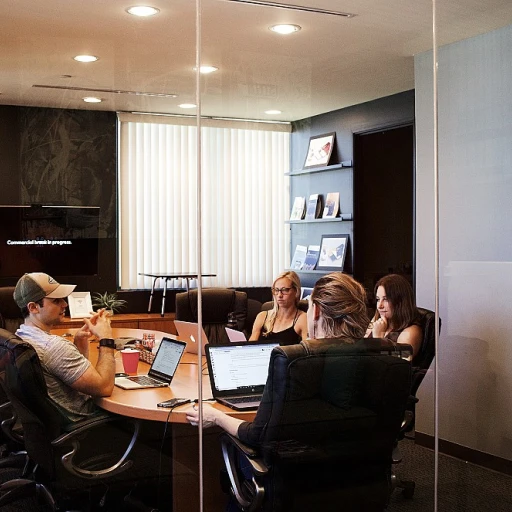
Navigating the Hybrid Work Model: Strategies and Tools
Navigating the Hybrid Work Model
Embracing the hybrid work model requires dexterity and foresight, especially in the post-pandemic workplace. According to McKinsey & Company, 80% of employees enjoy work-from-home arrangements and hope to maintain this flexibility 1. It's critical for office managers to adopt strategies and tools that support this operational shift.
Equipping Teams with Collaborative Technology
Utilizing platforms like Slack, Microsoft Teams, and Zoom can bridge the communication gap between remote and in-office personnel. A stunning 92% of workers expect to video conference weekly, indicating the need for robust tech solutions 2. Integration of these tools promotes inclusivity, ensuring no team member is left in the metaphorical dark.
Establishing Clear Hybrid Policies
Clear policies eliminate confusion and set expectations about when and how often employees should be in the office. Salesforce, for example, has implemented a 'flex' policy, allowing employees to decide when they come into the office, pending team needs 3. Documentation and training around these policies will be paramount for a smooth transition.
Adaptive Scheduling for Peak Performance
Hybrid schedules should hinge on peak productivity times and individual roles. Office managers can use project management tools like Asana or Trello to keep track of progress and ensure efficacy regardless of location. Statistics show that individuals with control over their schedules report a 24% drop in burnout and a 30% boost in work-life balance 4.
Measurement of Productivity and Outcomes
Transitioning to a hybrid model means productivity can't solely be measured by hours in the office. Instead, setting specific KPIs (Key Performance Indicators) and OKRs (Objectives and Key Results) provides tangible metrics for success. Harvard Business Review notes that companies using OKRs have seen a 56% increase in goal achievement 5.
Subsequent parts of this series look into maintaining health and safety standards, mental health support, leveraging technology for efficient office management, and maintaining employee engagement—all integral components in the post-pandemic office terrain.
Maintaining Health and Safety Standards in the Office
Embracing the Hybrid Work Model with Effective Strategies
The hybrid work model has become a mainstay in the post-pandemic landscape, challenging office managers to balance remote and in-office work seamlessly. According to a survey by Gartner, 82% of company leaders intend to permit remote working some of the time. To navigate this shift, office managers must implement strategic scheduling tools and communication platforms that optimize both remote and on-site operations. Encouraging consistent use of collaborative software such as Microsoft Teams or Slack ensures that both streams of the workforce remain connected and productive.
Equipping Teams with the Right Tools for Success
One cannot overemphasize the importance of equipping teams with the right tools to thrive in a hybrid environment. Statistics reveal that employees with access to efficient technologies are 230% more engaged in their jobs. As an office manager, fostering an ecosystem where project management tools like Asana or Trello are readily available can significantly enhance team workflow and project tracking. Moreover, cloud-based solutions play a pivotal role in real-time data access and file management for a dispersed workforce.
Innovating Scheduling to Accommodate Hybrid Work
- Flexible Scheduling: Utilize scheduling software to allocate in-office days, ensuring reduction in office density and adherence to health and safety protocols.
- Hot Desking Systems: Implement systems to reserve desks and resources, minimizing waste and maintaining social distancing.
- Team Rotations: Design a balanced rotation system to have essential team members on-site when needed, promoting mental health support through regular interaction.
By weaving flexible work arrangements into the fabric of the work environment, office managers can foster a culture of trust and empowerment, which in turn can contribute to the overall well-being and engagement of employees.
Empowering Staff with Autonomous Decision Making
Empowerment is a crucial element of the hybrid work model. A study by Forbes indicates that employees with higher autonomy report a 76% increase in job satisfaction. Office managers should strive to establish a culture where remote workers can make decisions without constant oversight. This autonomy creates a sense of ownership and can lead to innovative problem-solving, cutting-edge productivity, and a more agile office management.
Overcoming Connectivity Barriers
Lastly, connectivity stands as a common challenge in remote settings. Investing in robust VPN systems and ensuring that all team members have access to high-speed internet is not just a luxury, it's a necessity in sustaining operational efficiency. Office managers must act as advocates for resources that bridge the connectivity gap to maintain a cohesive, unified team dynamics regardless of physical location.
Implementing Mental Health Support Initiatives
Upholding Office Health Standards in a New Era
As office managers, the health and safety of your team is paramount. In the wake of the pandemic, this aspect has surged in importance, becoming a non-negotiable in the modern workplace. Workplace health and safety statistics underscore the urgency: according to the Health and Safety Executive (HSE), in the UK, 1.7 million working people are suffering from a work-related illness in 2020/21. This compels office managers to be vigilant and proactive.
To tackle this, protocols for regular cleaning and disinfection must be established, considering the frequency of cleaning to mitigate risks. Furthermore, staying aligned with the latest health and safety guidelines is crucial for ensuring compliance and demonstrating commitment to employee wellbeing.
Constructing a Robust Sanitation Framework
- Regularly scheduled deep-cleaning sessions
- Hand sanitation stands throughout the office
- Adequate ventilation systems
- Policies for sickness reporting and sick leave
Illustrating the significance, a recent ISSA report indicates that enhanced cleaning can reduce absenteeism by up to 46%. These steps not only keep the office space safe but also instill confidence in the workforce.
Ensuring Mental Well-being Through Physical Safety
Establishing a sense of physical safety is intrinsically tied to the mental health of your personnel. The facility’s hygiene directly influences the office ambience and, by extension, the team’s peace of mind. The Chartered Institute of Personnel and Development (CIPD) notes that supportive workplace environments lead to lower levels of work-related stress, making the integration of physical health measures a cornerstone for overall employee well-being.
Key takeaways:- Regular risk assessments and modifications to the office layout to allow for social distancing can be essential.
- Incorporating signage to communicate key safety information reduces confusion and reinforces safe practices.
- Adopting a clear policy on face coverings, considering individual needs and governmental advice, balances safety with personal comfort.
Remember, 'Safety cultivates productivity,' as Jenny Devine, a renowned office management strategist, claims. It’s not just about adherence to norms; it’s a foundation for building a resilient and efficient office environment.
Technology's Role in Health Standard Management
While manual systems have their place, embracing technology can dramatically enhance the management of health and safety standards. For instance, health and safety management software can automate record-keeping, track incident reports, and create an audit trail. According to a Verdantix survey, 85% of EHS executives plan to increase their investment in technology, linking effective health and safety management with technological adoption.
Remember, enabling technologies should integrate seamlessly with other office management systems, creating a cohesive infrastructure that supports staff well-being and streamlines workflows.
Leveraging Technology for Streamlined Office Management
Addressing Mental Well-Being in Modern Office Environments
As we adapt to the evolving office landscape, the importance of supporting employee mental health has never been clearer. According to a report by Mind, a worrisome 60% of adults and 68% of young people claimed their mental health deteriorated during the lockdown. Office managers can play a pivotal role in mitigating this trend by establishing robust mental health support frameworks. Utilizing mental health days, providing access to wellness resources, or introducing Employee Assistance Programs (EAPs) can create a safety net that protects employees during tough times.
Cultivating a Supportive Culture through Initiatives and Training
As eloquently put by Richard Branson, "Take care of your employees, and they'll take care of your business." Crafting a workplace that prizes mental well-being begins with training leaders and fostering a culture that's openly supportive of mental health issues. Encouraging dialogue and providing stress management training are more than just token gestures—they are essential steps in building a truly empathetic and resilient workplace. Statistics show that workplaces with established mental health practices see a return of $4 for every $1 invested in improved mental health—illustrating the profound impact thoughtful policies can have.
Enhancing Work-Life Balance with Flexible Schedules
Amidst the backdrop of a hybrid work model, the distinction between work and personal life blurs. A staggering 70% of workers, according to statistics by FlexJobs, believe that job flexibility significantly improves their quality of life. Office managers can lead the way in mental health advocacy by implementing flexible scheduling. This acts as both a tool for managing stress and a way to accommodate the unique needs of every employee, echoing the specificity required for truly personal support.
Utilizing Technology to Support Employee Mental Health
When it comes to office management, leveraging technology smartly can extend to supporting mental health. Online mental health platforms and mobile applications can offer 24/7 assistance and serve as an instrumental part of your company's support system. The judicious integration of these tools, coupled with the strategic technological infrastructure already discussed, represents a deep dive into employee well-being, offering detail and analytics to proactively spot and address mental health concerns before they escalate.
Building Resilience through Team-Building and Mindfulness Exercises
To instill a strong sense of community and fortify emotional resilience, team-building activities coupled with mindfulness exercises can be transformative. Various studies have revealed that mindfulness exercises can reduce stress levels, with empirical evidence pointing to a decrease of up to 31% in stress markers. Interweaving these exercises into the core fabric of the workplace can turn them into instructional cornerstones for mental health, guiding employees towards a more balanced and engaged presence at work.
Fostering Employee Engagement and Culture in a Changing Workplace
Maximizing Efficiency with Cutting-Edge Office Tech
As an expert in office management, it's evident that leveraging technology is not just a convenience—it's an essential strategy for thriving in today's post-pandemic environment. According to a recent survey, 85% of managers agree that digital tools have become more important post-pandemic. To streamline office administration, robust tools like project management software, virtual meeting platforms, and cloud-based filing systems are indispensable. These solutions not only improve productivity but also enable better collaboration across physically dispersed teams.
- Project Management Software: Trello, Asana, and Monday.com have reshaped the way tasks are tracked and managed.
- Virtual Meeting Platforms: Zoom and Microsoft Teams have become the gold standard in connecting remote and in-office personnel.
- Cloud-based Services: Google Workspace and Microsoft 365 allow for real-time document collaboration and file management.
Empowering Remote Collaboration
Emphasizing the human aspect of remote work, it's clear that technology has a profound role in maintaining interpersonal connections. Virtual collaborative tools have surged in necessity, with statistics indicating a 400% increase in their usage since the onset of the pandemic. Office managers can facilitate organic interactions among staff through social intranets or communication platforms like Slack, which bridge the gap between physical distances and enhance team rapport.
Automating for a Boundless Office Environment
Automation technologies such as AI-powered chatbots, scheduling assistants, and HR management systems reclaim countless hours of manual labor. "Office managers can redirect their focus from tedious tasks to strategic planning," states James Clear in his productivity insights. Indeed, recent data suggests that automating administrative tasks can result in a 40% rise in operational efficiency, highlighting the transformative power of these advancements.
Securing Data and Enhancing Cybersecurity
In the digital age, a robust cybersecurity protocol is a non-negotiable pillar of office management. A staggering 68% of business leaders note cybersecurity concerns have increased post-pandemic. Leveraging security software, conducting regular IT audits, and ensuring compliance with data protection laws are vital steps. Office managers must also cultivate a culture of security awareness among employees to mitigate risks and protect valuable company data.
Integrating Smart Office Solutions
We are now at the frontier of the smart office era, where IoT devices can automate climate control, lighting, and even book meeting rooms. Statistics showcase a rising trend in smart office adoption, with an estimated 15.5% growth rate forecasted through 2024. This move not only reflects an eco-friendly attitude but also speaks to the increased productivity and well-being of employees who work in such dynamic spaces.

-large-full.webp)

